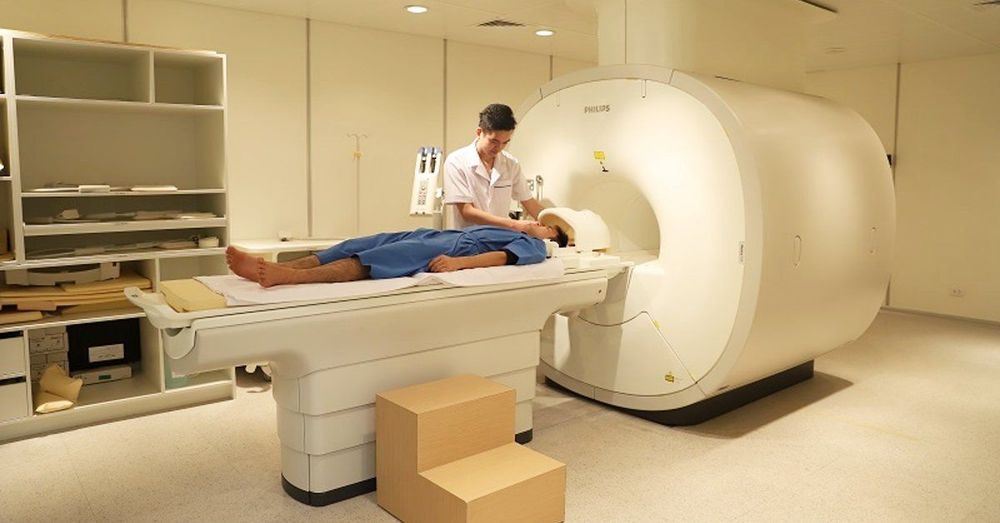This is an automatically translated article.
The article was written by BSCKI.ThS.BS Trinh Le Hong Minh - Radiologist - Radiology Department - Vinmec Central Park International General Hospital.
The advantage of MRI of the spine is that it gives completely objective, honest and clear images to guide treatment, especially deciding whether to have surgery or not. Images of lesions on discs, articular cartilage, ligaments, synovial membrane, subchondral bone are easily observed, especially when reconstructing on three-dimensional images.
1. What problems does an MRI of the cervical spine help to detect?
Magnetic resonance imaging of the cervical spine will help you and your doctor detect the following problems:
Congenital abnormalities or malformations of the cervical spine Infections in the cervical spine or adjacent to the cervical spine Injuries of the cervical spine Abnormal curvature of the spine, also known as scoliosis Tumors or cancers of the cervical spine.

Chụp MRI cột sống cổ giúp phát hiện các bệnh lý về cột sống cổ
2. Indications and contraindications for cervical spine magnetic resonance imaging (MRI)
2.1 Indication for magnetic resonance imaging (MRI) of the cervical spine You will be ordered to have a cervical spine MRI when you have the following problems:
Neck, shoulder, or arm pain that cannot be treated with accompanying neck pain leg weakness, limb numbness, or other symptoms Tumors of bone or soft tissue Disc prolapse, or herniated disc Aneurysms in the arteries, or blood vessel abnormalities Other soft tissue abnormalities , bone or joint abnormalities in the neck
2.2 Contraindications to magnetic resonance imaging (MRI) of the cervical spine Contraindications to magnetic resonance imaging of the cervical spine include:
Patients with pacemakers may not be advised to undergo magnetic resonance imaging. Patients with a metal foreign body in the eye, or with a clip placed in the brain, cannot have magnetic resonance imaging because the magnetic field can cause displacement of the metals. Patients who are afraid of being confined may not be able to tolerate being in the MRI room, in which case they should be anesthetized to make the patient more comfortable. Patients with metal devices placed in the back (such as screws in the spine) can have MRI, but the image quality will be reduced.

Chụp cộng hưởng từ (MRI) cột sống cổ cần được thực hiện tại bệnh viện uy tín
3. How to take pictures? Does it cause pain? Do you need a contrast agent?
How to shoot:You will be placed on a movable tabletop. Straps and padding will be used to help you stay still and in position. Devices with coils capable of sending and receiving radio waves can be placed around you or near the area of your body to be imaged. Magnetic resonance imaging usually involves many different pulse sequences, which can last many minutes. For magnetic resonance imaging of the cervical spine, the device will be placed around the neck. If contrast injection is needed, a doctor, nurse, or technician will place an intravenous needle into a vein in your arm to give the contrast medication. You will be placed in the magnetic field of the magnetic resonance room. The technician will perform the scan through an external computer. Once the scan is complete, you may be asked by your radiologist to wait to check the images and take more if needed. The intravenous line will be withdrawn about 30 minutes after the scan is over. The entire scan usually takes about 20-30 minutes. Does it cause pain?
Magnetic resonance imaging is painless, you just need to lie still. When you move, the magnetic resonance image will be blurred. The MRI table can be hard and cold, but you can ask for blankets/blankets and a pillow to support your head. Magnetic resonance machine will make noise during the shooting, you may ask to wear headphones or earplugs to reduce noise.
4. What should be noted before/after shooting?
Note before the scan:
You should tell your doctor about your health problems, recent surgeries or allergies, and whether you are currently pregnant or not. Magnetic fields will not cause harm, but may cause some medical equipment to fail. Most orthopedic implants are not affected, but you should always tell the technician if you have any metal devices in place. Guidelines for eating and drinking before a neck MRI will vary depending on the specific disease. In most cases you will take your medicine as usual. Please leave your jewelry at home and wear cool, comfortable clothing. You may be asked to wear a hospital uniform. If you're nervous or have claustrophobia, you can talk to your doctor to ask for a light sedation before your neck MRI.

Trước khi chụp MRI, bác sĩ sẽ trao đổi với bạn một số vấn đề cần lưu ý
Notes after the scan:
Most patients can go home right after the face-neck magnetic resonance imaging is done and return to their daily activities. Patients who are sedated or have contrast injections may require short-term monitoring. If contrast is used, you may develop a blood clot under the skin at the injection site; but this is harmless and will go away on its own. When a large hematoma causes swelling and discomfort, apply ice first; After 24 hours, you apply warm water to dissolve the hematoma. Vinmec International General Hospital put into use the 3.0 Tesla Silent technology magnetic resonance imaging machine. Magnetic resonance imaging machine 3.0 Tesla with Silent technology of GE Healthcare (USA).
Silent technology is especially beneficial for patients who are children, the elderly, weak health patients and patients undergoing surgery. Limiting noise, creating comfort and reducing stress for customers during the shooting process, helping to capture better quality images and shorten the shooting time. Magnetic resonance imaging technology is the technology applied in the most popular and safest imaging method today because of its accuracy, non-invasiveness and non-X-ray use. Customers can go directly to the system. Vinmec Health System nationwide to visit or contact the hotline here for support.
Reference article: mountsinai.org
MORE:
The role of magnetic resonance imaging (MRI) in the diagnosis of spinal and lumbar diseases Magnetic resonance imaging for diagnosis of spinal hernia "Tracing" lesions spine by magnetic resonance imaging (MRI)














